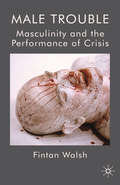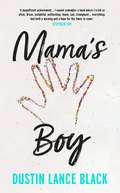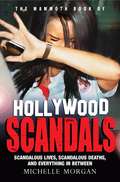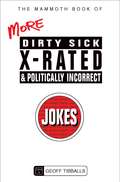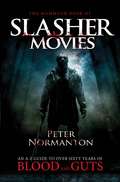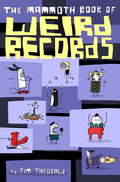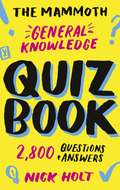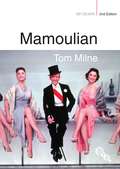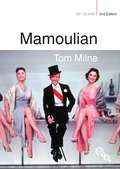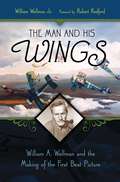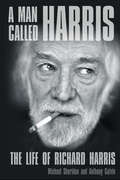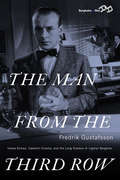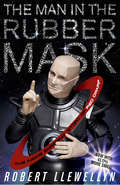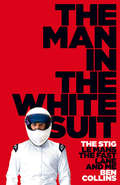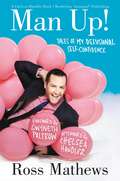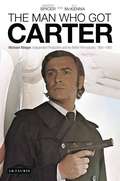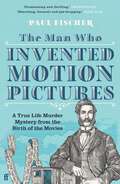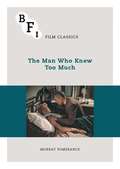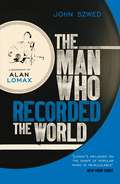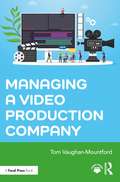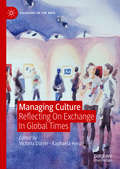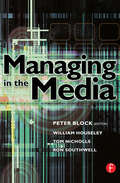- Table View
- List View
Male Rape Victimisation on Screen
by Victoria M. NagyResearch has established that men are unlikely to report being victimised by sexual assault, often out of feelings of embarrassment, shame, fear, and emasculation. Critically examining how the rape of men and boys is represented in television and film, Male Rape Victimisation on Screen argues how presentations of male sexual assault in popular culture have reinforced rape myths associated with male victimisation, as well as the barriers of toxic masculinity that seethe beneath its surface. Employing a feminist and popular criminology framework, Victoria M. Nagy conducts a comprehensive analysis of a range of both adult and child television programmes and films from the past several decades to reveal how rape myths have pervaded popular culture. Turning to reality and the broader implications this has for men who are and are not victims of sexual violence, Nagy explores how knowledge gained from this research can feed into sexual violence prevention efforts and inform a necessary shift in our cultural mindset. Focusing on the under-researched area of male sexual assault, this book broaches cultural, criminology, gender, film, and media studies to reveal how seemingly harmless humour can infiltrate how we think about violent and victimising behaviours.
Male Trouble: Masculinity and the Performance of Crisis
by F. WalshA rich analysis of the discourses and figurations of 'crisis masculinity' around the turn of the twenty-first century, working at the intersection of performance and cultural studies and looking at film, television, drama, performance art, visual art and street theatre.
Mama's Boy: A Memoir
by Dustin Lance Black'A magnificent achievement . . . I cannot remember a book where I cried so often. Brave, insightful, unflinching, funny, sad, triumphant . . . everything. And both a warning and a hope for the times to come' STEPHEN FRYDustin Lance Black wrote the Oscar-winning screenplay for Milk and helped overturn California's anti-gay marriage Proposition 8, but he grew up in a conservative Mormon household outside San Antonio, Texas. His mother, Anne, was raised in rural Louisiana, and contracted polio when she was two years old. She endured brutal surgeries, as well as braces and crutches for life, and was told that she would never have children or a family. Willfully defying expectations, she found salvation in an unlikely faith, raised three sons, and escaped the abuse and violence of two questionably devised Mormon marriages before finding love and an improbable career in the U.S. civil service.When Lance came out to his mother at twenty-one, he was already studying the arts instead of going on his Mormon mission. She derided his sexuality as a sinful choice and was terrified for his future. Mama's Boy explores what it took to remain a family despite such division-a journey that stretched from the steps of the U.S. Supreme Court to the woodsheds of East Texas. In the end, the rifts that have split a nation couldn't end this relationship that defined and inspired their remarkable lives. Mama's Boy is their story. It's a story of the noble quest for a plane higher than politics - one of family, foundations, turmoil, tragedy, elation, and love. It is a story needed now more than ever.'To outsiders, my mom and I should have been enemies. Our house should have been divided -- North vs South, red vs blue, conservative vs progressive, or however you want to put it. Instead, my mom and I fuelled each other. Her oil lit my lamp, and eventually mine lit hers. The tools I'd learned to wield growing up in her conservative, Christian, southern, military home were the same I'd used to wage battles that had taken me from a broken-down welfare apartment where gunfire sang me to sleep, to the biggest stages in the world, and to the front row of the United States Supreme Court to fight for LGBTQ equality.'
The Mammoth Book of Hollywood Scandals (Mammoth Books)
by Michelle MorganMurders, suicides, unexplained deaths, scandalous romances, illegitimate children, cover-ups, and more, from the 1920s to Hollywood's Golden Age in the 1960s and right up to the present day.It covers over 60 scandals including: The Roscoe 'Fatty' Arbuckle Scandal; Clark Gable's Baby Scandals; The Rape of Patricia Douglas; The Life and Death of Jean Harlow; The Sudden Death of James Dean; Marilyn Monroe's Mysterious Death; John Belushi Dies at the Chateau Marmont; Madonna's Hollywood Stalker; Hugh Grant's Hollywood Scandal; Winona Ryder Is Arrested For Shoplifting; The Brad Pitt, Jennifer Aniston and Angelina Jolie Love Triangle; The Tragic Life and Death of Anna Nicole Smith; The Life and Death of Michael Jackson; Arnold Schwarzenegger's Love Child; The Very Public Melt-Down of Charlie Sheen; The Rise and Fall of Whitney Houston; The Marriage of Tom Cruise and Katie Holmes and many, many more.
The Mammoth Book of More Dirty, Sick, X-Rated and Politically Incorrect Jokes (Mammoth Books #458)
by Geoff TibballsFunny, fearless and absolutely filthy-nearly 3,000 more uncensored, dirty, sick, and deeply politically incorrect jokes, covering just about every topic imaginable, from adultery to (sex in) Zoos, including an assortment of bad taste lists. A worthy, all-new follow-on to the first bestselling volume.
The Mammoth Book of Slasher Movies (Mammoth Books #409)
by Peter NormantonAn engrossing A-Z of over 60 gory years of slasher and splatter movies, from Danny Boyle's 28 Days Later to Lucio Fulci's Zombie Flesh Eaters. Here you will find the low-down on over 250 movies with entries from 23 different countries. The index, which includes every movie mentioned in the A-Z and accompanying notes, runs to 540 movies. The book includes the list of video nasties which the UK government attempted to ban.
The Mammoth Book Of Weird Records (Mammoth Books)
by Jim TheobaldEveryone’s heard of Usain Bolt, but how many people know about Dineka Maguire? Like Bolt, the Irish woman is a world record holder but in the rather lesser known sport of bog snorkelling. She is just one of the hundreds of unsung heroes featured in this book chronicling the people who go to bizarre lengths to break world records in the weirdest categories; people who devote hours of intense training to spitting dung, eating cockroaches, sniffing feet or tossing tuna in the hope of one day being recognised as the best in the world. This astonishing compendium of the weirdest, wackiest and most disgusting world records will amuse and astound in equal measure.Entries include:Longest ear hairFastest marathon while wearing a deep-sea diving suitFastest bog snorkellerFarthest distance skateboarding by a goatMost bees on bodyMost milk crates balanced on head Fastest 5-km run while dressed as a penguin and jugglingHeaviest airplane pulled with teethFastest shopping trolleyLongest backwards motorcycle rideMost stairs climbed by bicycleFastest 30 metres on a scooter by a dogFirst water-skiing squirrel
The Mammoth General Knowledge Quiz Book: 2,800 Questions and Answers
by Nick HoltA bumper collection of 2,800 questions and answers to test even the most ardent quiz fanatic.
Mamoulian (BFI Silver)
by Tom MilneThe great Armenian-American director Rouben Mamoulian (1897-1987) remains a favourite among film-makers, his films combining great technical originality with a uniquely poetic visual style. Mamoulian's technical innovations are evident from his first film, Applause (1923), in which he incorporated two separate soundtracks into one printing, thus overcoming the difficulty of sound levels which had frustrated the pioneer directors of 'talkies', and in Dr Jekyll and Mr Hyde (1931), in which he used synthetic sound painted directly onto the soundtrack. Such inventive solutions to film-making challenges were linked to Mamoulian's abiding sense of the magic of the cinema. Heused colour as a dramatic ingredient in the first three-strip Technicolour film, Becky Sharp (1935), and his musicals Summer Holiday (1948) and Silk Stockings (1957) were remarkable in their time for the way in which the dance was used to enhance the drama and to illuminate character. And for Garbo, in Queen Christina (1933) he created the framework for her greatest role. Tom Milne's classic study, first published in 1969, provides a film-by-film analysis of Mamoulian's career and challenges widespread critical assumptions about the director's oeuvre. In his foreword to this new edition, Geoff Andrew recognises Milne's careful and insightful analysis of Mamoulian's expressive and imaginative style and asks whether this unique director ought to be considered as an auteur. Andrew also pays tribute to Milne's elegant, witty and eclectic critical style and hails him as one the most important and influential British writers on film.TOM MILNE (1926-2005) was a leading British film critic, contributing to Sight & Sound, the Monthly Film Bulletin, The Observer, The Financial Times and The Times during his career. During the 1960s he worked at the British Film Institute as Associate Editor of Sight & Sound and Editor of The Monthly Film Bulletin. His other publications include a monograph on Joseph Losey (1967), a short study on the Danish director Carl Theodor Dreyer (1971) and an anthology of interviews and writings on Jean-Luc Godard (1972) that he edited and translated.Foreword by GEOFF ANDREW, Head of Film Programme at BFI Southbank, UK, and the author of several books including Nicholas Ray: Poet of Nightfall (BFI, 2004) and, in the BFI Film Classics series, volumes on Kieslowski's Three Colours Trilogy and Kiarostami's 10.
Mamoulian (BFI Silver)
by Tom MilneThe great Armenian-American director Rouben Mamoulian (1897-1987) remains a favourite among film-makers, his films combining great technical originality with a uniquely poetic visual style. Mamoulian's technical innovations are evident from his first film, Applause (1923), in which he incorporated two separate soundtracks into one printing, thus overcoming the difficulty of sound levels which had frustrated the pioneer directors of 'talkies', and in Dr Jekyll and Mr Hyde (1931), in which he used synthetic sound painted directly onto the soundtrack. Such inventive solutions to film-making challenges were linked to Mamoulian's abiding sense of the magic of the cinema. Heused colour as a dramatic ingredient in the first three-strip Technicolour film, Becky Sharp (1935), and his musicals Summer Holiday (1948) and Silk Stockings (1957) were remarkable in their time for the way in which the dance was used to enhance the drama and to illuminate character. And for Garbo, in Queen Christina (1933) he created the framework for her greatest role. Tom Milne's classic study, first published in 1969, provides a film-by-film analysis of Mamoulian's career and challenges widespread critical assumptions about the director's oeuvre. In his foreword to this new edition, Geoff Andrew recognises Milne's careful and insightful analysis of Mamoulian's expressive and imaginative style and asks whether this unique director ought to be considered as an auteur. Andrew also pays tribute to Milne's elegant, witty and eclectic critical style and hails him as one the most important and influential British writers on film.TOM MILNE (1926-2005) was a leading British film critic, contributing to Sight & Sound, the Monthly Film Bulletin, The Observer, The Financial Times and The Times during his career. During the 1960s he worked at the British Film Institute as Associate Editor of Sight & Sound and Editor of The Monthly Film Bulletin. His other publications include a monograph on Joseph Losey (1967), a short study on the Danish director Carl Theodor Dreyer (1971) and an anthology of interviews and writings on Jean-Luc Godard (1972) that he edited and translated.Foreword by GEOFF ANDREW, Head of Film Programme at BFI Southbank, UK, and the author of several books including Nicholas Ray: Poet of Nightfall (BFI, 2004) and, in the BFI Film Classics series, volumes on Kieslowski's Three Colours Trilogy and Kiarostami's 10.
The Man and His Wings: William A. Wellman and the Making of the First Best Picture
by William Wellman Jr.William Wild Bill Wellman was not Paramount Pictures' first choice to direct the World War I epic Wings (1927), but as a former aviator and war hero, he was the right choice. Despite months waging epic battles of his own with studio executives, Wild Bill managed to finish the big-budget war saga by inventing many of the techniques still used to film aerial battle scenes. The film, starring Clara Bow, broke box office records and earned its studio the first Academy Award for Best Picture. Considered by many to be the last great film of the silent era, Wings has been cited as a major influence on such directors as Martin Scorsese and Robert Redford. Its director, who went on to direct the likes of John Wayne, James Cagney, and Gary Cooper, later earned an Oscar for writing one of Hollywood's most loved (and often remade) films, A Star is Born. In this biography, the director's son, William Wellman Jr., reveals the war hero, family man, occasional prankster, and underestimated visionary who changed Hollywood forever.Augmented with personal correspondence from Wellman's own World War I tour of duty as a fighter pilot, on-set photographs from Wings and other classic Hollywood films, and anecdotes from the back lots of the early studio system, this unique work traces the way in which the first Best Picture's director used his own war experience to bring a war epic to the screen. The versatile director also excelled at comedies such as Nothing Sacred (1937), and had a lasting influence on the gangster genre with The Public Enemy (1931), starring James Cagney. With the recent release of Wellman's later aviation classics, Island in the Sky (1953) and The High and the Mighty (1954), both starring John Wayne, Wellman is gaining renewed attention and appreciation from a new generation of film enthusiasts. The book ends with a detailed Filmography of more than 75 classic films directed by Wellman.
A Man Called Harris: The Life of Richard Harris
by Michael Sheridan Anthony GalvinRichard Harris was a giant who oozed charisma on screen. But off screen he was troubled and addicted to every pleasure life could offer. Coming from a repressed Irish Catholic background, he was forced by a teenage illness to abandon his beloved rugby, but not his macho appetites. Discovering theatre saved him. He had found his calling. Despite marrying the daughter of a peer, he never tried to fit in. He was always a hell-raiser to the core, along with legendary buddies Richard Burton and Peter O’Toole. But he was more; he was a gifted poet and singer. He was an intelligent family man who took great interest in his craft, a Renaissance man of the film world. Every time his excesses threatened to kill his career – and himself – he rose magnificently from the ashes, first with an Oscar-winning performance as Bull McCabe in The Field, then in the Harry Potter franchise.
The Man from the Third Row: Hasse Ekman, Swedish Cinema and the Long Shadow of Ingmar Bergman
by Fredrik GustafssonUntil his early retirement at age 50, Hasse Ekman was one of the leading lights of Swedish cinema, an actor, writer, and director of prodigious talents. Yet today his work is virtually unknown outside of Sweden, eclipsed by the filmography of his occasional collaborator (and frequent rival) Ingmar Bergman. This comprehensive introduction—the first ever in English—follows Ekman’s career from his early days as a film journalist, through landmark films such as Girl with Hyacinths (1950), to his retirement amid exhaustion and disillusionment. Combining historical context with insightful analyses of Ekman’s styles and themes, this long overdue study considerably enriches our understanding of Swedish film history.
The Man from the Third Row: Hasse Ekman, Swedish Cinema and the Long Shadow of Ingmar Bergman
by Fredrik GustafssonUntil his early retirement at age 50, Hasse Ekman was one of the leading lights of Swedish cinema, an actor, writer, and director of prodigious talents. Yet today his work is virtually unknown outside of Sweden, eclipsed by the filmography of his occasional collaborator (and frequent rival) Ingmar Bergman. This comprehensive introduction—the first ever in English—follows Ekman’s career from his early days as a film journalist, through landmark films such as Girl with Hyacinths (1950), to his retirement amid exhaustion and disillusionment. Combining historical context with insightful analyses of Ekman’s styles and themes, this long overdue study considerably enriches our understanding of Swedish film history.
The Man In The Rubber Mask: The Inside Smegging Story of Red Dwarf
by Robert LlewellynIt was 1989 when Robert Llewellyn first had his head encased in the one-piece latex foam-rubber balaclava that is the head of Kryten in Red Dwarf series three, and it gave him a distinctly funny turn.Gazing at his own reflection and seeing the face of a mechanoid robot staring back was surprisingly scary, not to mention uncomfortable and rather sweaty. And he couldn't even eat his lunch.Since then, he has sweated, frozen, been set on fire, exploded, spent thousands of hours in the make-up chair and thousands more being taunted by Craig Charles for being a middle-class b*****d. So it is a testament to the joyful camaraderie and life-enhancing silliness of the world of Red Dwarf that twenty-three years later, Robert is still willing to risk life, limb and hairline to don the rubber torture helmet for Red Dwarf X, the recent triumphant return of the motley band of space bums.Originally published in 1993 after series six, The Man in the Rubber Mask has now been completely updated with 43.7% extra smeg.
The Man in the White Suit: The Stig, Le Mans, The Fast Lane And Me
by Ben CollinsThe Stig gets his kit off and reveals how he came to be Top Gear's iconic racing driver and so much more - including what it's like to thrash an Aston Martin DBS, train for the Army and face the terror of Jeremy Clarkson's underwear…
Man Up!: Tales of My Delusional Self-Confidence (A Chelsea Handler Book/Borderline Amazing Publishing)
by Ross MathewsIn this hilarious and inspirational memoir, Ross Mathews-best known as "Ross the Intern" from The Tonight Show with Jay Leno-chronicles his life growing up as an atypical kid in a small Northwestern farm town to living as an atypical adult in Los Angeles, to eventually being his loud, proud, apologetically genuine self on national television.As a young kid growing up in a farm town, Ross Mathews might as well have wished for a pet unicorn or a calorie-free cookie tree to grow in his front yard. Either of those far-fetched fantasies would have been more likely to come true than his real dream: working in television in Hollywood, California. Seriously, that stuff just doesn't happen to people like Ross. But guess what? It totally did.Now, with his first book, Ross takes us inside his journey as a super-fan, revealing the most embarrassing and hilarious moments of his small-town life and big-city adventures. From learning to swear like a hardened trucker to that time in high school when had to face down the most frightening opponent of all (his girlfriend's lady bits), Ross holds nothing back. Oh, then there's his surprisingly shady past involving the cutest pair of plus-sized women's pajama bottoms, deliciously dangerous pot butter, and embezzled sandwiches. And, of course, how he's managed to turn an obsession with pop-culture into one-on-one interactions with celebrities like Gwyneth Paltrow, Tiffani-Amber Theissen, Madonna, Michelle Kwan, and countless more without ever having a single restraining order issued against him.Infused with Ross's trademark humor, unique voice, and total honesty, Man Up! is a mission statement for anyone who doesn't fit the mold. His hasn't been the most traditional way to build a career in Hollywood, but Ross has somehow managed to make his mark without ever compromising who he is. He is as serious about this as he is about Golden Girls trivia: You don't need to change who you are to achieve your dreams (although there's nothing wrong with a makeover every now and then). You just need to Man Up!
The Man Who Got Carter: Michael Klinger, Independent Production and the British Film Industry, 1960-1980 (International Library Of The Moving Image Ser.)
by Andrew Spicer A.T. McKenna A. T. McKennaMichael Klinger was the most successful independent producer in the British film industry over a twenty year period, from 1960 to 1980, responsible for 32 films, including classics such as Repulsion and Get Carter. Despite working with many famous figures, including Michael Caine, Claude Chabrol, Mike Hodges, Lee Marvin and Roman Polanski, Klinger's contribution to British cinema has been ignored.This definitive book on Klinger, largely based on his previously unseen personal papers, examines his origins in the Sixties' Soho sex industry, sexploitation cinema and 'shockumentaries', through to major international productions, including Shout at the Devil. It reveals how Klinger deftly combined commercial product – the popular 'Confessions' series – with artistic, experimental cinema and highlights the importance of his Jewishness. The book also assesses the essential, often misunderstood role played by the producer.
The Man Who Invented Motion Pictures: A True Tale of Obsession, Murder and the Movies
by Paul FischerLouis Le Prince invented the motion picture in 1890. He applied for, and was granted, patents in four countries. And then, a month before unveiling it to the world...he disappeared. And was never seen again.Three years later, Le Prince's invention was finally made public - by a man who claimed to have invented it himself. The man's name was Thomas Edison.This book is the story of the birth of motion pictures, restoring the father of the invention to his rightful place in history.
The Man Who Knew Too Much (BFI Film Classics)
by Murray PomeranceMurray Pomerance offers an illuminating account of one of Hitchcock's most intruiging and successful films, The Man Who Knew Too Much (1956), starring James Stewart and Doris Day. Through a close reading of the film alongside analysis of its complex production history, Pomerance's analysis highlights its darkest nuances, and its themes of musicality, gendered power, and cultural strangeness. He proposes that, far from being a merely charming escapade, the film tells a strange story of doubling, spiritual presence, and the intricacies of social organisation.
The Man Who Recorded the World: A Biography of Alan Lomax
by John SzwedWriter, musicologist, archivist, singer, DJ, filmmaker, record, radio and TV producer, Alan Lomax was a man of many parts. Without him the history of popular music would have been very different. Armed with a tape-recorder and his own near-flawless good taste, Lomax spent years travelling the US, particularly the south, recording its heritage of music and song for posterity, bringing to light the talents of performers ranging from Jelly Roll Morton to Leadbelly and Muddy Waters, and crucially influencing generations of musicians from Pete Seeger to the Stones, from Woody Guthrie to Bob Dylan. His influence continues: recordings made by Lomax are the core of the sound-tracks of Oh Brother, Where art Thou? and Gangs of New York, and even featured, remixed, on Moby's Play. John Szwed's biography is the first ever of this remarkable and contradictory man (whom he both knew and worked with for ten years); through it Szwed will tell the story of a musical and political era, as he did so successfully in his previous book on Miles Davis.
Managing a Video Production Company
by Tom Vaughan-MountfordProviding a detailed break-down of the skills required to establish and grow a profitable production company, this book enables content creators and filmmakers to navigate the commercial video production world and the needs of its clients. Drawing on professional experience in the industry as well historical examples, author Tom Vaughan-Mountford illustrates the ways in which producers can avoid common pitfalls and better manage their business, projects, and clients. Making the corporate world accessible for filmmakers, this book covers all aspects of the video production process, equipping creatives with the tools—and the mindset—to offer their skills to paying clients in a reliable, repeatable, and above all profitable manner. This book is ideal for filmmakers and content creators looking to establish a successful video production business, and features an online resource pack with example production paperwork including a call sheet, and example script re-writes.
Managing a Video Production Company
by Tom Vaughan-MountfordProviding a detailed break-down of the skills required to establish and grow a profitable production company, this book enables content creators and filmmakers to navigate the commercial video production world and the needs of its clients. Drawing on professional experience in the industry as well historical examples, author Tom Vaughan-Mountford illustrates the ways in which producers can avoid common pitfalls and better manage their business, projects, and clients. Making the corporate world accessible for filmmakers, this book covers all aspects of the video production process, equipping creatives with the tools—and the mindset—to offer their skills to paying clients in a reliable, repeatable, and above all profitable manner. This book is ideal for filmmakers and content creators looking to establish a successful video production business, and features an online resource pack with example production paperwork including a call sheet, and example script re-writes.
Managing Culture: Reflecting On Exchange In Global Times (Sociology of the Arts)
by Raphaela Henze Victoria DurrerThis book provides new insights into the relationship of the field of arts and cultural management and cultural rights on a global scale.Globalisation and internationalisation have facilitated new forms for exchange between individuals, professions, groups, localities and nations in arts and cultural management. Such exchanges take place through the devising, programming, exhibition, staging, marketing, and administration of project activities. They also take place through teaching and learning within higher education and cultural institutions, which are now internationalised practices themselves. With a focus on the fine, visual and performing arts, the book positions arts and cultural management educators and practitioners as active agents whose decisions, actions and interactions represent how we, as a society, approach, relate to, and understand ourselves and others. This consideration of education and practice as socialisation processes with global, political and social implications will be an invaluable resource to academics, practitioners and students engaging in arts and cultural management, cultural policy, cultural sociology, global and postcolonial studies.
Managing in the Media
by William Houseley Tom Nicholls Ron Southwell Pamela BlockManaging in the Media has been devised for a broad audience. It is based upon the perceived need for a text that amalgamates cultural theories, film and television analysis, management theories and media production practice into one volume. There are many books on film and cultural studies. Similarly, there are copious numbers of texts written on management. To date little has been written that analyses the management of the audiovisual industry set against the backdrop of the cultural and economic environment within which the media manager operates. Managing in the Media is divided into three sections that take the reader from the global to the specific, from the strategic to the tactical. Each chapter discusses specific topics that can be read in isolation yet contribute to the theme within each part. Taken as a whole, the book provides the potential professional media manager and current practising media manager with a framework of issues that will give them an awareness of the range of knowledge needed by the successful media manager. This book does not try to be a manual to success. The media industry is awash with successful individuals none of whom needed textbooks to set them on their chosen career paths. Yet these exceptional people prove the rule; that in the main, most media practitioners would benefit from some additional support and guidance. The aim of this book is to present to them some of the management issues that have, or will have, an impact upon their working careers. The accompanying website www.mediaops.net (which can also be accessed via www.focalpress.com) features:- Tutor notes and reader activities- Updated list of further reading- Additional support material such as production templates - Interviews with the authors - A discussion forum- Industry and education links- Media News

